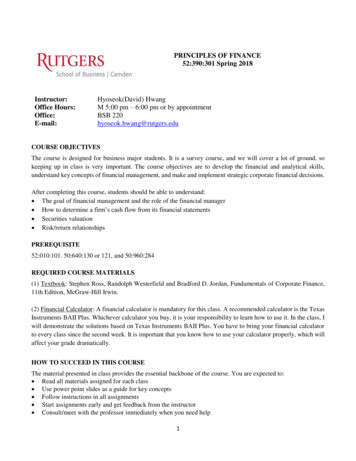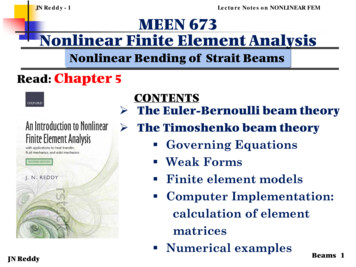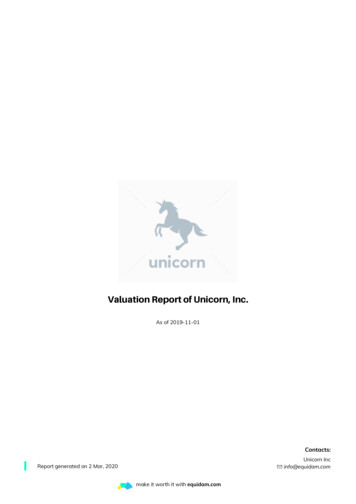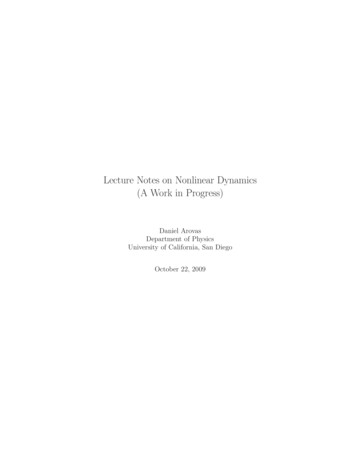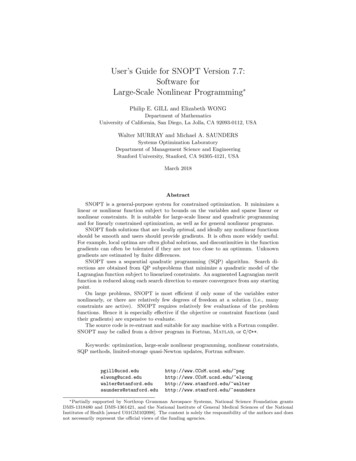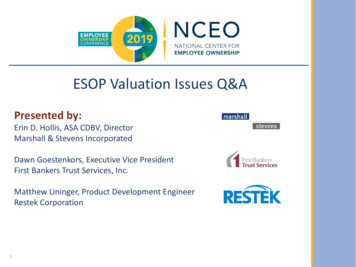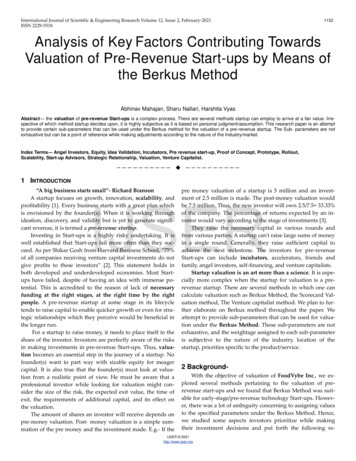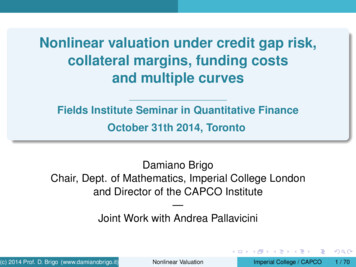
Transcription
Nonlinear valuation under credit gap risk,collateral margins, funding costsand multiple curvesFields Institute Seminar in Quantitative FinanceOctober 31th 2014, TorontoDamiano BrigoChair, Dept. of Mathematics, Imperial College Londonand Director of the CAPCO Institute—Joint Work with Andrea Pallavicini(c) 2014 Prof. D. Brigo (www.damianobrigo.it)Nonlinear ValuationImperial College / CAPCO1 / 70
Content I1Credit Risk under collateralizationCVA, DVA, Collateral and Gap Risk2Funding CostsValuation under Funding CostsThe recursive non-decomposable nature of adjusted pricesBSDEs, Nonlinear PDEs and an Invariance TheoremBenchmark case: Black ScholesFunding costs, aggregation and nonlinearitiesNVA3Multiple Interest Rate curves4CCPs: Initial margins, clearing members defaults, delays.References(c) 2014 Prof. D. Brigo (www.damianobrigo.it)Nonlinear ValuationImperial College / CAPCO2 / 70
See the 2004-2014 papers in the References andBooks:especially the first one (most recent).(c) 2014 Prof. D. Brigo (www.damianobrigo.it)Nonlinear ValuationImperial College / CAPCO3 / 70
Credit Risk under collateralizationCVA, DVA, Collateral and Gap RiskCVA, DVA and CollateralWe are a investment bank ”I” trading with a counterparty ”C”.Credit Valuation Adjustment (CVA)is the reduction in price we ask to ”C” for the fact that ”C” may default.See B. and Tarenghi (2004) and B. and Masetti (2005).Debit Valuation Adjustment (DVA)is the increase in price we face towards ”C” for the fact that we maydefault. See B. and Capponi (2008). In very simple contexts, DVA canalso be interpreted as a funding benefit.CVA/DVA are complex options on netting sets.containing hundreds of risk factors and with a random maturity givenby the first to default between ”I” and ”C”(c) 2014 Prof. D. Brigo (www.damianobrigo.it)Nonlinear ValuationImperial College / CAPCO4 / 70
Credit Risk under collateralizationCVA, DVA, Collateral and Gap RiskCVA, DVA and CollateralCVA and DVA can be sizeableCitigroup in its press release on the first quarter revenues of 2009reported a positive mark to market due to its worsened credit quality:“Revenues also included [.] a net 2.5 billion positive CVA onderivative positions, excluding monolines, mainly due to the wideningof Citi’s CDS spreads” (DVA)CVA mark to market losses: BIS”During the financial crisis, however, roughly two-thirds of lossesattributed to counterparty credit risk were due to CVA losses and onlyabout one-third were due to actual defaults.”(c) 2014 Prof. D. Brigo (www.damianobrigo.it)Nonlinear ValuationImperial College / CAPCO5 / 70
Credit Risk under collateralizationCVA, DVA, Collateral and Gap RiskCollateral and Gap RiskCollateral is a guarantee following mark to market.and posted from the party that is facing a negative variation of mark tomarket in favour of the other party. If one party defaults, the other partymay use collateral to cover their losses.However, even under daily collateralization.there can be large mark to market swings due to contation that makecollateral rather ineffective. This is called GAP RISK and is one of thereasons why Central Clearing Counterparties (CCPs) and the newstandard CSA have an initial margin as well.Example of Gap Risk (from B. Capponi Pallavicini (2011)):(c) 2014 Prof. D. Brigo (www.damianobrigo.it)Nonlinear ValuationImperial College / CAPCO6 / 70
Credit Risk under collateralization(c) 2014 Prof. D. Brigo (www.damianobrigo.it)CVA, DVA, Collateral and Gap RiskNonlinear ValuationImperial College / CAPCO7 / 70
Credit Risk under collateralizationCVA, DVA, Collateral and Gap RiskCollateral Management and Gap Risk IThe figure refers to a payer CDS contract as underlying.See full paper B., Capponi and Pallavicini (2011) for more cases.Figure: relevant CVA component (part of the bilateral DVA - CVA)starting at 10 and ending up at 60 under high correlation.Collateral very effective in removing CVA when correlation 0CVA goes from 10 to 0 basis points.Collateral not effective as default dependence growsCollateralized and uncollateralized CVA become closer and for highcorrelations still get 60 basis points of CVA, even under collateral.Instantaneous contagion CVA option moneyness jump at default(c) 2014 Prof. D. Brigo (www.damianobrigo.it)Nonlinear ValuationImperial College / CAPCO8 / 70
Funding CostsInclusion of Funding CostWhen managing a trading position, one needs to obtain cash in orderto do a number of operations:borrowing / lending cash to implement the replication strategy,possibly repo-lending or stock-lending the replication risky asset,borrowing cash to post collateralreceiving interest on posted collateralpaying interest on received collateralusing received collateral to reduce borrowing from treasuryborrowing to pay a closeout cash flow upon defaultand so on. Where are such founds obtained from?(c) 2014 Prof. D. Brigo (www.damianobrigo.it)Nonlinear ValuationImperial College / CAPCO9 / 70
Funding CostsInclusion of Funding CostWhen managing a trading position, one needs to obtain cash in orderto do a number of operations:borrowing / lending cash to implement the replication strategy,possibly repo-lending or stock-lending the replication risky asset,borrowing cash to post collateralreceiving interest on posted collateralpaying interest on received collateralusing received collateral to reduce borrowing from treasuryborrowing to pay a closeout cash flow upon defaultand so on. Where are such founds obtained from?Obtain cash from her Treasury department or in the market.receive cash as a consequence of being in the position.All such flows need to be remunerated:if one is ”borrowing”, this will have a cost,and if one is ”lending”, this will provide revenues.(c) 2014 Prof. D. Brigo (www.damianobrigo.it)Nonlinear ValuationImperial College / CAPCO9 / 70
Funding CostsValuation under Funding CostsIntroduction to Quant. Analysis of Funding Costs IWe now present an introduction to funding costs modeling. Motivation?Funding Value Adjustment Proves Costly to J.P. Morgan’s 4Q Results(Michael Rapoport, Wall St Journal, Jan 14, 2014)”[.] So what is a funding valuation adjustment, and why did it cost J.P.Morgan Chase 1.5 billion? [.]J.P. Morgan was persuaded to make the FVA [Funding ValuationAdjustment] change by an industry migration toward such a move [.]Some banks already recognize funding valuation adjustments, likeRoyal Bank of Scotland, which recognized FVA losses of 174 millionpounds in 2012 and 493 million pounds in 2011. Goldman Sachs says[.] that its derivatives valuations incorporate FVA(c) 2014 Prof. D. Brigo (www.damianobrigo.it)Nonlinear ValuationImperial College / CAPCO10 / 70
Funding CostsValuation under Funding CostsIntroduction to Quant. Analysis of Funding Costs IIWe now approach funding costs modeling by incorporatingfunding costs into valuation, adding new cash flows.We start from scratch from the product cash flows and addcollateralization, cost of collateral, CVA and DVA after collateral, andfunding costs for collateral and for the replication of the product.In the following τI denotes the default time of the investor / bank doingthe calculation of the price. ”C” denotes the counterparty.(c) 2014 Prof. D. Brigo (www.damianobrigo.it)Nonlinear ValuationImperial College / CAPCO11 / 70
Funding CostsValuation under Funding CostsBasic Payout plus Credit and Collateral: Cash Flows IWe calculate prices by discounting cash-flows under the pricingmeasure. Collateral and funding are modeled as additionalcashflows (as for CVA and DVA)We start from derivative’s basic cash flows without credit,collateral of funding risksV̄t: Et [ Π(t, T τ ) . . . ]where τ : τC τI is the first default time, and Π(t, u) is the sum of all payoff terms from t to u, discounted at tCash flows are stopped either at the first default or at portfolio’sexpiry if defaults happen later.(c) 2014 Prof. D. Brigo (www.damianobrigo.it)Nonlinear ValuationImperial College / CAPCO12 / 70
Funding CostsValuation under Funding CostsBasic Payout plus Credit and Collateral: Cash Flows IIAs second contribution we consider the collateralization procedureand we add its cash flows.V̄t : Et [ Π(t, T τ ) ] Et [ γ(t, T τ ; C) . . . ]where Ct is the collateral account defined by the CSA, γ(t, u; C) are the collateral margining costs up to time u.The second expected value originates what is occasionally calledLiquidity Valuation Adjustment (LVA) in simplified versions of thisanalysis. We will show this in detail later.If C 0 collateral has been overall posted by the counterparty toprotect us, and we have to pay interest c .If C 0 we posted collateral for the counterparty (and we areremunerated at interest c ).(c) 2014 Prof. D. Brigo (www.damianobrigo.it)Nonlinear ValuationImperial College / CAPCO13 / 70
Funding CostsValuation under Funding CostsBasic Payout plus Credit and Collateral: Cash Flows IIIThe cash flows due to the margining procedure on the time grid{tk } are equal to (Linearization of exponential bond formulas inthe continuously compounded rates)γ(t, u; C) n 1X1{t tk u} D(t, tk )Ctk αk (c̃tk (tk 1 ) rtk (tk 1 ))k 1where αk tk 1 tk and the collateral accrual rates are given byc̃t : ct 1{Ct 0} ct 1{Ct 0}Note that if the collateral rates in c̃ are both equal to the risk freerate, then this term is zero.(c) 2014 Prof. D. Brigo (www.damianobrigo.it)Nonlinear ValuationImperial College / CAPCO14 / 70
Funding CostsValuation under Funding CostsClose-Out: Trading-CVA/DVA under Collateral – IAs third contribution we consider the cash flow happening at 1stdefault, and we haveV̄t: Et [ Π(t, T τ ) ] Et [ γ(t, T τ ; C) ] Et 1{τ T } D(t, τ )θτ (C, ε) . . .where ετ is the close-out amount, or residual value of the deal at default,which we called NPV earlier, and θτ (C, ε) is the on-default cash flow.θτ will contain collateral adjusted CVA and DVA payouts for theinstument cash flows(c) 2014 Prof. D. Brigo (www.damianobrigo.it)Nonlinear ValuationImperial College / CAPCO15 / 70
Funding CostsValuation under Funding CostsClose-Out: Trading-CVA/DVA under Collateral – IIWe define θτ including the pre-default value of the collateralaccount since it is used by the close-out netting rule to reduceexposureIn case of no collateral re-hypothecation (see full paper for allcases)θτ (C, ε) : ετ 1{τ τC τI } ΠCVAcoll 1{τ τI τC } ΠDVAcollΠCVAcoll LGDC (ε τ Cτ )ΠDVAcoll LGDI (( ετ ) ( Cτ ) ) (c) 2014 Prof. D. Brigo (www.damianobrigo.it)Nonlinear ValuationImperial College / CAPCO16 / 70
Funding CostsValuation under Funding CostsFunding Costs of the Replication Strategy – IAs fourth and last contribution we consider the cost of funding forthe hedging procedures and we add the relevant cash flows.V̄t : Et [ Π(t, T τ ) ] Et γ(t, T τ ; C) 1{τ T } D(t, τ )θτ (C, ε) Et [ ϕ(t, T τ ; F , H) ]The last term, especially in simplified versions, is related to whatis called FVA in the industry. We will point this out once we get ridof the rate r . Ft is the cash account for the replication of the trade, Ht is the risky-asset account in the replication, ϕ(t, u; F , H) are the cash F and hedging H funding costs up to u.In classical Black Scholes on Equity, for a call option (no creditrisk, no collateral, no funding costs),V̄tCall t St ηt Bt : Ht Ft ,(c) 2014 Prof. D. Brigo (www.damianobrigo.it)Nonlinear Valuationτ , C γ ϕ 0.Imperial College / CAPCO17 / 70
Funding CostsValuation under Funding CostsFunding Costs of the Replication Strategy – IIContinuously compounding format and linearizing exponentials:ϕ(t, u) m 1X 1{t tj u} D(t, tj )(Ftj Htj )αk rtj (tj 1 ) f̃tj (tj 1 )j 1 m 1X 1{t tj u} D(t, tj )Htj αk rtj (tj 1 ) h̃tj (tj 1 )j 1f̃t: ft 1{Ft 0} ft 1{Ft 0} h̃t : ht 1{Ht 0} ht 1{Ht 0}The expected value of ϕ is related to the so called FVA. If thetreasury funding rates f̃ are same as asset lending/borrowing h̃ϕ(t, u) m 1X 1{t tj u} D(t, tj )Ftj αk rtj (tj 1 ) f̃tj (tj 1 )j 1If further treasury borrows/lends at risk free f̃ r ϕ FVA 0.(c) 2014 Prof. D. Brigo (www.damianobrigo.it)Nonlinear ValuationImperial College / CAPCO18 / 70
Funding CostsValuation under Funding CostsFunding Costs of the Replication Strategy – IIIOur replica consists in F cash and H risky asset.Cash is borrowed F 0 from the treasury at an interest f (cost) or islent F 0 at a rate f (revenue)Risky asset position in the replica is worth H. Cash needed to buyH 0 is borrowed at an interest f from the treasury; in this case H canbe used for asset lending (Repo for example) at a rate h (revenue);Else if risky asset in replica is worth H 0, meaning that we shouldreplicate via a short position in the asset, we may borrow cash from therepo market by posting the asset H as guarantee (rate h , cost), andlend the obtained cash to the treasury to be remunerated at a rate f .It is possible to include the risk of default of the funder and funded,leading to CVA and DVA adjustments for the funding position, see PPB.(c) 2014 Prof. D. Brigo (www.damianobrigo.it)Nonlinear ValuationImperial College / CAPCO19 / 70
Funding CostsValuation under Funding CostsFunding rates depend on Treasury policiesIn real applications the funding rate f̃t is determined by the partymanaging the funding account for the investor, eg the bank’streasury: trading positions may be netted before funding on the mkt a Funds Transfer Pricing (FTP) process may be implemented togauge the performances of different business units; a maturity transformation rule can be used to link portfolios toeffective maturity dates; sources of funding can be mixed into the internal funding curve . . .In part of the literature the role of the treasury is usuallyneglected, leading to controversial results particularly when thefunding positions are not distinguished from the trading positions.See partial claims “funding costs DVA”, or “there are no fundingcosts”, cited in the literature(c) 2014 Prof. D. Brigo (www.damianobrigo.it)Nonlinear ValuationImperial College / CAPCO20 / 70
Funding CostsThe recursive non-decomposable nature of adjusted pricesRecursive non-decomposable Nature of Pricing – I ( ) V̄t Et Π(t, T τ ) γ(t, T τ ) 1{τ T } D(t, τ )θτ (C, ε) ϕ(t, T τ )Can we interpret: Et Π(t, T τ ) 1{τ T } D(t, τ )θτ (C, ε) : RiskFree Price DVA - CVA? Et [ γ(t, T τ ) ϕ(t, T τ ; F , H) ] : Funding adjustment FVA?Not really. This is not a decomposition. It is an equation. In fact sinceV̄t Ft Ht Ct (re–hypo)the ϕ present value depends on future Ft V̄t Ht Ct and thecloseout θ, via and C, depends on future V̄ . Terms feed each other:no neat separation. Recursive pricing: Nonlinear PDE’s / BSDEs for V̄”FinalPrice RiskFreePrice ( DVA?) - CVA FVA” not possible.See Pallavicini Perini B. (2011, 2012) for V̄ equations and algorithms.See also the analysis in Wu (2013).(c) 2014 Prof. D. Brigo (www.damianobrigo.it)Nonlinear ValuationImperial College / CAPCO21 / 70
Funding CostsThe recursive non-decomposable nature of adjusted pricesRecursive non-decomposable Nature of Pricing – IIWrite a valuation PDE (or BSDE) by a continuous time limit in theprevious equations and by an immersion hypothesis for credit risk.We obtain (here πt dt Π(t, t dt))ZTE{D(t, u; r λ)[πu (ru c̃u )Cu λu θuV̄t t (ru f̃u )(Fu Hu ) (h̃u ru )Hu ] Ft }du EQFund1We can also writeZ TV̄t E{D(t, u; r λ)[πu λu θu (f̃u c̃u )Cu t (ru f̃u )Vu (h̃u ru )Hu ] Ft }du EQFund2(c) 2014 Prof. D. Brigo (www.damianobrigo.it)Nonlinear ValuationImperial College / CAPCO22 / 70
Funding CostsThe recursive non-decomposable nature of adjusted pricesRecursive non-decomposable Nature of Pricing – IIIWrite this last eq as a BSDEs by completing the martingale term.d V̄t (f̃t λt )V̄t dt (f̃t c̃t )Ct dt πt dt λt θ(Ct , V̄t )dt (r h̃)Ht dt dMt ,V̄t Ht Ft Ct , εt V̄t (replacement closeout), V̄T 0.Recall that f̃ depends on V̄ nonlinearly, and so does c̃ on C and h̃on H. M is a martingale under the pre-default filtration.BSDEs for valuation under asymmetric borrowing/lending ratesThese had been introuced in a short example in El Karoui, Peng andQuenez (1997). We are adding credit gap risk and collateralprocesses, adding discontinuities and more nonlinearity into thepicture.(c) 2014 Prof. D. Brigo (www.damianobrigo.it)Nonlinear ValuationImperial College / CAPCO23 / 70
Funding CostsThe recursive non-decomposable nature of adjusted pricesRecursive non-decomposable Nature of Pricing – IVAssume a Markovian vector of underlying assets S (pre- creditand funding) with diffusive generator Lr ,σ under Q, whose 2ndorder part is L2 . Let this be associated with brownian W under Q.1dS rSdt σ(t, S)SdWt , Lr ,σ u(t, S) rS S u σ(t, S)2 S 2 S2 u2Use Ito’s formula on V̄ (t, S) and match dt (and dW ) terms: obtainPDE (& explicit representation for BSDE term ZdW ).V̄tAssume Delta Hedging: Ht St SThis leads to(c) 2014 Prof. D. Brigo (www.damianobrigo.it)Nonlinear ValuationImperial College / CAPCO24 / 70
Funding CostsThe recursive non-decomposable nature of adjusted pricesRecursive non-decomposable Nature of Pricing – VNonlinear PDE( t f̃t λt Lh̃,σ )V̄t (f̃t c̃t )Ct πt λt θ(Ct , V̄t ) 0,V̄T 0.NonlinearitiesThis NPDE is NON-LINEAR not only because of θ, but also because f̃depends on F , and h̃ on H, and hence both on V̄ itself.IMPORTANT INVARIANCE THEOREM:THIS PDE DOES NOT DEPEND ON r .This is good, since r is a theoretical rate that does not correspond toany market observable. Only market rates here.(c) 2014 Prof. D. Brigo (www.damianobrigo.it)Nonlinear ValuationImperial College / CAPCO25 / 70
Funding CostsThe recursive non-decomposable nature of adjusted pricesRecursive non-decomposable Nature of Pricing – VIWe may now use nonlinear Feynman Kac to rewrite this last PDE, freefrom r , as an expected value. We obtainEQFund3: Deal-dependent probability measure for valuationZ TV̄t Eh̃ {D(t, u; f̃ λ)[πu λu θu (f̃u c̃u )Cu ] Ft }dutEhHereis the expected value under a probability measure where theunderlying assets evolve with a drift rate (return) of h̃.Remember: h̃ depends on H, and hence on V .PRICING MEASURE DEPENDS ON FUTURE VALUES OF THEVERY PRICE V WE ARE COMPUTING. Nonlinear expectationEVERY DEAL/PORTFOLIO HAS A SEPARATE PRICING MEASUREBy rearranging terms in the previous EQFund1, it is tempting.(c) 2014 Prof. D. Brigo (www.damianobrigo.it)Nonlinear ValuationImperial College / CAPCO26 / 70
Funding CostsThe recursive non-decomposable nature of adjusted pricesRecursive non-decomposable Nature of Pricing – VII. it is tempting to set V̄ RiskFreePrice LVA FVA - CVA DVAZRiskFreePrice T E D(t, u; r )1{τ u} πu δτ (u)εu Gt dutZLVA T E D(t, u; r )1{τ u} (ru c̃u )Cu Gt dutZTFVA E D(t, u; r )1{τ u} (ru f̃u )(Fu Hu ) (h̃u ru )Hu Gt dutZT E D(t, u; r )1{τ u} 1{u τC τI } ΠCVAcoll (u) Gt duT E D(t, u; r )1{τ u} 1{u τI τC } ΠDVAcoll (u) Gt du CVA tZDVA t(c) 2014 Prof. D. Brigo (www.damianobrigo.it)Nonlinear ValuationImperial College / CAPCO27 / 70
Funding CostsThe recursive non-decomposable nature of adjusted pricesRecursive non-decomposable Nature of Pricing – VIIIIf we insist in applying these equations, rather than the r -independentNPDE or EQFund3, then we need to find a proxy for r .r OIS. Further, if we assume h̃ f̃ then Z T FVA E D(t, u; r )1{τ u} (ru f̃u )Fu Gt dutNotice that when we are borrowing cash F , since usually f r , FVA isnegative and is a cost. Also LVA can be negative.The above decomposition however, as pointed out earlier, only makessense a posteriori and is not a real decomposition.(c) 2014 Prof. D. Brigo (www.damianobrigo.it)Nonlinear ValuationImperial College / CAPCO28 / 70
Funding CostsBenchmark case: Black ScholesBlack Scholes PDE credit, collateral and funding INPDE can be further specified by assuming for example Ct αt V̄t ,with α being Ft adapted and positive. Assume h̃ f̃ andf̃t f 1F 0 f 1F 0 , c̃t c 1V̄t 0 c 1V̄t 0 , f , and c , constants.NONLINEAR PDE (SEMILINEAR) t V f (V St S Vt αV ) f ( V St S Vt αV ) λt V 1 σ 2 S 2 S2 V c αt (Vt ) c αt ( Vt ) πt λt θt (Vt ) 02λ is the first to default intensity, π is the ongoing dividend cash flowprocess of the payout, θ are the complex optional contractual cashflows at default including CVA and DVA payouts after collateral. c andc are the borrowing and lending rates for collateral.(c) 2014 Prof. D. Brigo (www.damianobrigo.it)Nonlinear ValuationImperial College / CAPCO29 / 70
Funding CostsBenchmark case: Black ScholesBlack Scholes PDE credit, collateral and funding IIWe can use Lipschitz coefficients results to investigate ! of viscositysolutions. Classical soultions may also be found but require muchstronger assumptions and regularizations.The equation is consistent with Black Scholes: Iff f r , α 0, λ 0we get back t V (t, S) rS S V (t, S) (c) 2014 Prof. D. Brigo (www.damianobrigo.it)1 2 2 2σ S S V (t, S) rV (t, S),2Nonlinear ValuationImperial College / CAPCO30 / 70
Funding CostsFunding costs, aggregation and nonlinearitiesNonlinearities due to funding INONLINEAR PDEs cannot be solved as Feynman Kac expectations.Backward Stochastic Differential Equations (BSDEs)For NPDEs, the correct translation in stochastic terms are BSDEs. Theequations have a recursive nature and simulation is quite complicated.Aggregation–dependent and asymmetric valuationWorse, the valuation of a portfolio is aggregation dependent and isdifferent for the two parties in a deal. In the classical pricing theory a laBlack Scholes, if we have 2 or more derivatives in a portfolio we canprice each separately and then add up. Not so with funding. Withoutfunding, the price to one entity is minus the price to the other one. Notso with funding.(c) 2014 Prof. D. Brigo (www.damianobrigo.it)Nonlinear ValuationImperial College / CAPCO31 / 70
Funding CostsFunding costs, aggregation and nonlinearitiesNonlinearities due to funding IIConsistent global modeling across asset classes and risksOnce aggregation is set, funding valuation is non–separable. Holisticconsistent modeling across trading desks & asset classes neededValue depends on specific trading entities and their policies. Often oneforces symmetries and linearization to have funding included asdiscounting and avoid organizational/implementation problems.NVAIn the recent paper http://ssrn.com/abstract 2430696 weintroduce a Nonlinearity Valuation Adjustment (NVA), which analyzesthe double counting involved in forcing linearization. Our numericalexamples for simple call options show that NVA can easily reach 2 or3% of the deal value even in relatively standard settings.(c) 2014 Prof. D. Brigo (www.damianobrigo.it)Nonlinear ValuationImperial College / CAPCO32 / 70
Funding CostsFunding costs, aggregation and nonlinearitiesNonlinearities due to funding IIIEquity call option (long or short), r 0.01, σ 0.25, S0 100,K 80, T 3y , V0 28.9 (no credit risk or funding/collateral costs).Precise credit curves are given in the paper.NVA V̄0 (nonlinear ) V̄0 (linearized)Table: NVA with default risk and collateralizationDefault risk, lowaFunding Rates bps f300100 f100300f̂200200Default risk, highbLongShortLongShort-3.27 (11.9%)3.63 (10.6%)-3.60 (10.5%)3.25 (11.8%)-3.16 (11.4%)3.52 (10.2%)-3.50 (10.1%)3.13 (11.3%)The percentage of the total call price corresponding to NVA is reported in parentheses.aBased on the joint default distribution Dlow with low dependence.bBased on the joint default distribution Dhigh with high dependence.(c) 2014 Prof. D. Brigo (www.damianobrigo.it)Nonlinear ValuationImperial College / CAPCO33 / 70
Funding CostsFunding costs, aggregation and nonlinearitiesNonlinearities due to funding IVTable: NVA with default risk, collateralization and rehypothecationDefault risk, lowaFunding Rates bpsf 300100f 100300f̂200200Default risk, highbLongShortLongShort-4.02 (14.7%)4.50 (12.5%)-4.45 (12.4%)4.03 (14.7%)-3.91 (14.0%)4.40 (12.2%)-4.35 (12.0%)3.92 (14.0%)The percentage of the total call price corresponding to NVA is reported in parentheses.aBased on the joint default distribution Dlow with low dependence.bBased on the joint default distribution Dhigh with high dependence.(c) 2014 Prof. D. Brigo (www.damianobrigo.it)Nonlinear ValuationImperial College / CAPCO34 / 70
Funding CostsNVANVA for long call as a function of f f , with f 1%, f increasing over1% and f̂ increasing accordingly. NVA expressed as an additive pricecomponent on a notional of 100, risk free option price 29. Risk free closeout.For example, f f 25bps results in NVA -0.5 circa, 50 bps NVA -1(c) 2014 Prof. D. Brigo (www.damianobrigo.it)Nonlinear ValuationImperial College / CAPCO35 / 70
Funding CostsNVANVA for long call as a function of f f , with f 1%, f increasing over1% and f̂ increasing accordingly. NVA expressed as a percentage (in bps) ofthe linearized f̂ price. For example, f f 25bps results in NVA -100bps -1% circa, replacement closeout relevant (red/blue) for large f f (c) 2014 Prof. D. Brigo (www.damianobrigo.it)Nonlinear ValuationImperial College / CAPCO36 / 70
Multiple Interest Rate curvesMultiple Interest Rate CurvesDerive interest rate dynamics consistently with credit, collateral andfunding costs as per the above master valuation equations.We use our maket based (no rt ) master equation to price OIS &find OIS equilibrium rates. Collateral fees will be relevant here,driving forward OIS rates.Use master equation to price also one period swaps based onLIBOR market rates. LIBORs are market given and not modeledfrom first principles from bonds etc. Forward LIBOR ratesobtained by zeroing one period swap and driven both fromprimitive market LIBOR rates and by collateral fees.We’ll model OIS rates and forward LIBOR/SWAP jointly, using amixed HJM/LMM setupIn the paper we look at non-perfectly collateralized deals too,where we need to model treasury funding rates.See http://ssrn.com/abstract 2244580(c) 2014 Prof. D. Brigo (www.damianobrigo.it)Nonlinear ValuationImperial College / CAPCO37 / 70
CCPs: Initial margins, clearing members defaults, delays.Pricing under Initial Margins: SCSA and CCPs ICCPs: Default of Clearing Members, Delays, Initial Margins.Our general theory can be adapted to price under Initial Margins, bothunder CCPs and SCSA.The type of equations is slightly different but quantitative problems arequite similar.See B. and Pallavicini (2014) for details [35], JFE 1, pp 1-60. Here wegive a summary.(c) 2014 Prof. D. Brigo (www.damianobrigo.it)Nonlinear ValuationImperial College / CAPCO38 / 70
CCPs: Initial margins, clearing members defaults, delays.Pricing under Initial Margins: SCSA and CCPs IISo far all the accounts that need funding have been included within thefunding netting set defining Ft .If additional accounts needed, for example segregated initial margins,as with CCP or SCSA, their funding costs must be added.Initial margins kept into a segregated account, one posted by theinvestor (NtI 0) and one by the counterparty (NtC 0):Z uZ uϕ(t, u) : dv (rv fv )Fv D(t, v ) dv (fv hv )Hv D(t, v ) (1)Zt uZ u tICdv (fvN rv )NvI , dv (fvN rv )NvC tCtIwith ftN & ftN assigned by the Treasury to the initial margin accounts.f N 6 f as initial margins not in funding netting set of the derivative.(c) 2014 Prof. D. Brigo (www.damianobrigo.it)Nonlinear ValuationImperial College / CAPCO39 / 70
CCPs: Initial margins, clearing members defaults, delays.Pricing under Initial Margins: SCSA and CCPs IIIZ. tuCdv (fvN rv )NvCZ tuIdv (fvN rv )NvIAssume for example f r . The party that is posting the initial marginhas a penalty given by the cost of funding this extra collateral, whilethe party which is receiving it reports a funding benefit, but only if thecontractual rules allow to invest the collateral in low-risk activity,otherwise f r and there are no price adjustments.In the paper we also deal with delays in the closeout payments.(c) 2014 Prof. D. Brigo (www.damianobrigo.it)Nonlinear ValuationImperial College / CAPCO40 / 70
CCPs: Initial margins, clearing members defaults, delays.(c) 2014 Prof. D. Brigo (www.damianobrigo.it)Nonlinear ValuationImperial College / CAPCO41 / 70
CCPs: Initial margins, clearing members defaults, delays.CCP Pricing: Figure explanationTen-year receiver IRS traded with a CCPPrices are calculated from the point of view of the CCP clientMid-credit-risk for CCP clearing member, high for CCP client.Initial margin posted at various confidence levels q.Black continuous line: price inclusive of residual CVA and DVA aftermargining but not funding costsDashed black lines represent CVA and the DVA contributions.red line is the price inclusive both of credit & funding costs. Symmetricfunding policy. No wrong way correlation overnight/credit.Prices in basis points with a notional of one Euro.(c) 2014 Prof. D. Brigo (www.damianobrigo.it)Nonlinear ValuationImperial College / CAPCO42 / 70
CCPs: Initial margins, clearing members defaults, delays.CCP Pricing: Tables (see paper for WWR etc)Table: Prices of a ten-year receiver IRS traded with a CCP (or bilaterally) witha mid-risk parameter set for the clearing member (investor) and a high-riskparameter set for the client (counterparty) for initial margin posted at variousconfidence levels q. Prices are calculated from the point of view of the client(counterparty). Symmetric funding policy. WWR correlation ρ̄ is zero. Pricesin basis points with a notional of one Euro.q50.068.090.095.099.099.599.799.9Receiver, CCP, β β 1CVADVAMVAFVA-0.126 3.0800.000-0.1574-0.066 1.605-2.9330.1251-0.015 0.357-8.0370.5492-0.007
Credit Risk under collateralization CVA, DVA, Collateral and Gap Risk CVA, DVA and Collateral We are a investment bank "I" trading with a counterparty "C". Credit Valuation Adjustment (CVA) is the reduction in price we ask to "C" for the fact that "C" may default. See B. and Tarenghi (2004) and B. and Masetti (2005).
